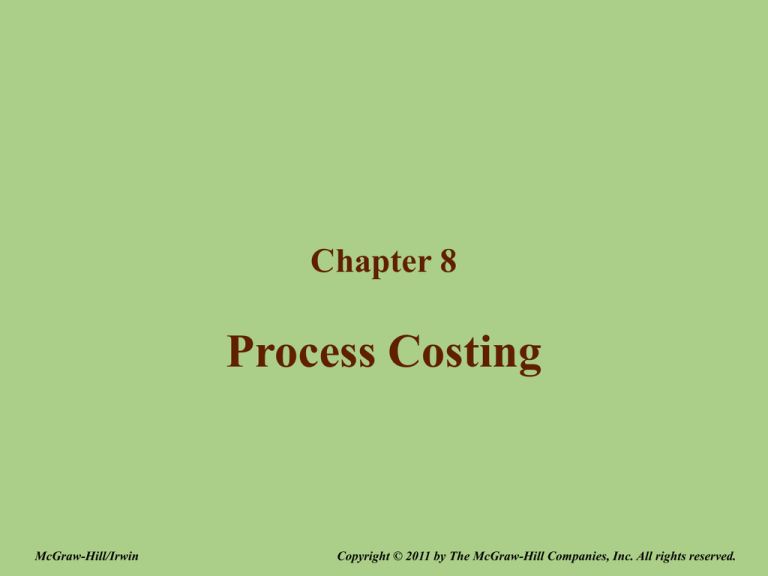
Chapter 8
Process Costing
McGraw-Hill/Irwin
Copyright © 2011 by The McGraw-Hill Companies, Inc. All rights reserved.
Determining Equivalent Units
L.O. 1 Explain the concept and purpose of equivalent units.
• Equivalent units:
Number of complete physical units to which units in
inventories are equal in terms of work done to date.
8-2
Using Product Costing
in a Process Industry
L.O. 2 Assign costs to products using a five-step process.
Step 1: Measure the physical flow of resources.
Step 2: Compute the equivalent units of production.
Step 3: Identify the product costs for which to account.
Step 4: Compute the costs per equivalent unit.
Step 5: Assign product cost to batches of work.
8-3
Steps 4 and 5
L.O. 3 Assign costs to products using weighted-average costing.
• Compute the costs per equivalent unit:
Weighted-average (Step 4)
• First, Steps 1, 2, and 3 must be revisited.
8-4
Measure the Physical
Flow of Resources (Step 1)
LO3
Gallons of
Compound
Work in process, March 1
+ Gallons of adhesive started
Total gallons to account for
20,000a
92,000
112,000
=Transferred out to Coating Department
+ Work-in-process, March 31
Total units accounted for
96,000
16,000b
112,000
a 25%
b
complete with respect to conversion costs
30% complete with respect to conversion costs
8-5
Compute the Equivalent Units
of Production (Step 2)
LO3
Compounding Department, March: Equivalent Units
Transferred out
Work-in-process, March 31
Total work
Physical
units
Equivalent units
Materials
Conversion
96,000
16,000
96,000
16,000a
112,000
96,000
4,800b
100,800
a 16,000
units × 100% (all materials added in beginning)
b 16,000 units × 30%
8-6
LO3
Identify the Product Costs for
Which to Account (Step 3)
Total
costs
Work in process, March 1
Current costs, March
Total
Materials
costs
Conversion
costs
$ 24,286 $ 16,160 $ 8,126
298,274
84,640 213,634
$322,560 $100,800 $221,760
8-7
LO3
Compute the Cost per
Equivalent Unit (Step 4)
Total
costs
Total costs (Step 3)
Total equivalent units (Step 2)
Cost per equivalent unit
Materials
costs
Conversion
costs
$322,560 $100,800 $221,760
112,000 100,800
$ 0.90 $
2.20
8-8
LO3
Assign Product Costs to
Batches of Work (Step 5)
Total
Transferred out:
Equivalent units
Cost per equivalent unit
Cost assigned
Work-in-process, March 31
Equivalent units
Cost per equivalent unit
Cost assigned
Total cost assigned
Materials
costs
Conversion
costs
96,000
96,000
$
0.90 $
2.20
$297,600 $ 86,400 $211,200
16,000
4,800
$
0.90 $
2.20
24,960
14,400
10,560
$322,560 $100,800 $221,760
8-9
The Production Cost Report
L.O. 4 Prepare and analyze a production cost report.
• The production cost report summarizes the
production and cost results for a period.
• It is used by managers to monitor production
and cost flows
• Following is 2T’s Compounding Department
production cost report (weighted-average
processing costing) for March.
8 - 10
LO4
Production Cost Report:
Weighted-Average Process Costing
Physical
units
Flow of units
Units to be accounted for:
In work-in-process beginning inventory
Units started this period
Total units to account for
20,000a
92,000
112,000
Units accounted for:
Completed and transferred out
In work-in-process ending inventory
Total units accounted for
96,000
16,000
112,000
a 100
% complete with respect to materials
b 30%
Equivalent units
Materials Conversion
96,000
16,000a
112,000
96,000
4,800b
100,800
complete with respect to conversion
8 - 11
LO4
Production Cost Report:
Weighted-Average Process Costing
Flow of costs
Costs to be accounted for:
Work-in-process beginning inventory
Current period costs
Total costs to be accounted for
Materials Conversion
Costs
Costs
Total
$ 24,286 $ 16,160 $ 8,126
298,274
84,640 213,634
$322,560 $100,800 $221,760
Cost per equivalent unit
$
0.90c $
2.20d
Costs accounted for:
Costs assigned to transferred-out units $297,600 $ 86,400e $211,200f
Costs assigned to WIP ending inventory
24,960
14,400g
10,560h
Total costs accounted for
$322,560 $100,800 $221,760
c $100,000
÷ 112,000 EU
f 96,000 EU × $2.20 per EU
d $221,760
÷ 100,800 EU
g 16,000 EU × $0.90 per EU
e 96,000
EU × $0.90 per EU
h 4,800 EU × $2.20 per EU
8 - 12
Assigning Costs Using FIFO
L.O. 5 Assign costs to products using first-in, first-out (FIFO) costing.
• Use the same five-step process.
• Step 1: Measure the physical flow of resources.
• Step 2: Compute the equivalent units of production.
• Step 3: Identify the product costs for which to account.
• Step 4: Compute the costs per equivalent unit.
• Step 5: Assign product cost to batches of work.
8 - 13
Determining Which is Better:
FIFO or Weighted-Average?
L.O. 6 Analyze the accounting choice between
FIFO and weighted-average costing.
• Weighted-average:
Does not separate prior period and current
period activities and costs.
• FIFO:
Separates prior period and current period
activities and traces the prior period and
current period costs to the respective units.
8 - 14
Choosing between Job
and Process Costing
L.O. 7 Know when to use process or job costing.
Job Costing
Process Costing
An accounting system
that traces costs to
individual units or to
specific jobs, contracts,
or batches of goods.
An accounting system
used when identical
units are produced
through a series of
uniform production steps.
Custom homes
Movies
Services
Corn flakes
Beverages
Paint
8 - 15
Operation Costing
L.O. 8 Compare and contrast operation costing
with job costing and process costing.
• Operation costing is a hybrid of job and
process costing.
• It is used in manufacturing goods that have
some common characteristics plus some
individual characteristics.
8 - 16
End of Chapter 8
McGraw-Hill/Irwin
Copyright © 2011 by The McGraw-Hill Companies, Inc. All rights reserved.







